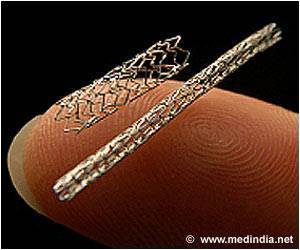Using artery opening stents along with medical therapy in patients with stable coronary artery disease who have at least one narrowed blood vessel reduces the risk of hospitalization.

"We believe there is a significant proportion of patients who benefit from stenting early on as opposed to receiving only medical therapy," said William Fearon, MD, associate professor of cardiovascular medicine at the Stanford University School of Medicine and co-principal investigator and senior author of the multi-center international trial called FAME 2. "For this group of patients who have significant ischemia [blood vessel narrowing that compromises flow to the heart muscle] based on assessment with FFR, the need for hospitalization and urgent revascularization is much higher and the pain relief is much less when only medical therapy is prescribed. People feel better and do better with FFR-guided placement of coronary stents up front in this setting."
The study's principal investigator is Bernard De Bruyne, MD, PhD, of Cardiovascular Center Aalst in Belgium.
The trial was halted early, on Jan. 15, because of the high rates of hospitalization and coronary stenting needed in the patients with significant ischemia who received only medical therapy. Some of those patients had suffered subsequent chest pain and heart attacks requiring urgent revascularization, which entails repairing damaged blood vessels with emergency stenting or heart bypass surgery.
Narrowing of the arteries caused by buildup of atherosclerotic plaque is common. About 40 percent of Americans over the age of 60 have one or more narrowings in the coronary arteries but no symptoms or stable symptoms, a condition known as stable coronary artery disease. Many can be treated with medical therapy alone, which may include aspirin or statins.
The idea for this trial grew out of the landmark COURAGE trial, presented in 2007, which found that stenting didn't provide any significant benefits over medical therapy for people with stable coronary artery disease. That trial relied solely on X-rays from coronary angiograms and noninvasive stress tests to determine which patients needed stenting.
The FAME 2 trial also used FFR, which involves inserting a coronary pressure guide wire into the artery to measure blood flow. In this study, it helped doctors pinpoint which patients would benefit from early stenting, as it identifies vessels with blood flow reduced to a dangerous level. As the study documented, these patients need stenting to prevent future adverse events.
The cost is low, an additional $700 compared to the average cost of a stent, which is roughly $2,000. And the FFR technology is available to most physicians, he said.
The study included 888 patients with at least one stenosis — one significantly narrowed artery causing ischemia — that was identified with FFR. An artery was considered seriously narrowed if the blood pressure was 80 percent or less past the narrowing than the pressure in front of the narrowing. Patients were enrolled in 28 centers in Europe, the United States and Canada. Fifty patients were enrolled at Stanford University Medical Center and the Veterans Affairs Palo Alto Health Care System in the portion of the trial led by Fearon.
Trial participants were randomly assigned to either medical therapy alone or medical therapy combined with stenting.
Patient enrollment began May 15, 2010. By Jan. 15 of this year, 75 patients in the trial had experienced at least one "cardiac event," such as the need for hospitalization and an urgent stent or a heart attack. The rate of these events was 4.3 percent for patients randomized to stents plus medical therapy compared with 12.7 percent in patients assigned to medical therapy.
Source-Eurekalert
 MEDINDIA
MEDINDIA



 Email
Email






